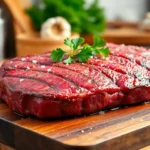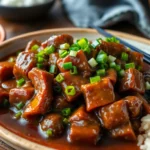Nothing beats the rich aroma of beef stew simmering on your stovetop on a cold winter day. This hearty comfort food transforms tough cuts of beef into melt-in-your-mouth tender pieces swimming in a flavorful broth that’ll warm you from the inside out. We’ve perfected this classic recipe to deliver restaurant-quality results using just one pot and your trusty stove.
Our foolproof stovetop method eliminates the guesswork and delivers consistent results every time. You’ll love how the beef becomes incredibly tender while the vegetables maintain their texture and the gravy develops that deep savory flavor we all crave. This isn’t just another beef stew recipe – it’s the ultimate comfort food that brings families together around the dinner table.
What makes our version special is the perfect balance of ingredients and timing that creates layers of flavor without any fancy equipment or complicated techniques.
Ingredients
Our beef stew recipe requires carefully selected ingredients that work together to create layers of flavor and the perfect texture. We’ve organized these ingredients into three categories to help you prepare this comforting dish efficiently.
For the Beef Stew
- 2 pounds beef chuck roast, cut into 2-inch cubes
- 3 tablespoons all-purpose flour
- 2 tablespoons vegetable oil
- 1 tablespoon tomato paste
- 4 cups beef broth
- 1 cup red wine (optional, can substitute with additional broth)
- 2 tablespoons Worcestershire sauce
For the Vegetable Base
- 1 large yellow onion, diced
- 3 large carrots, peeled and cut into 1-inch pieces
- 3 celery stalks, chopped into 1-inch pieces
- 1 pound baby potatoes, halved (or 3 large russet potatoes, cubed)
- 8 ounces mushrooms, quartered
- 4 garlic cloves, minced
- 2 tablespoons butter
Seasonings and Herbs
- 2 bay leaves
- 1 teaspoon dried thyme
- 1 teaspoon dried rosemary
- 1 teaspoon salt
- 1/2 teaspoon black pepper
- 1/4 teaspoon smoked paprika
- 2 tablespoons fresh parsley, chopped (for garnish)
Equipment Needed
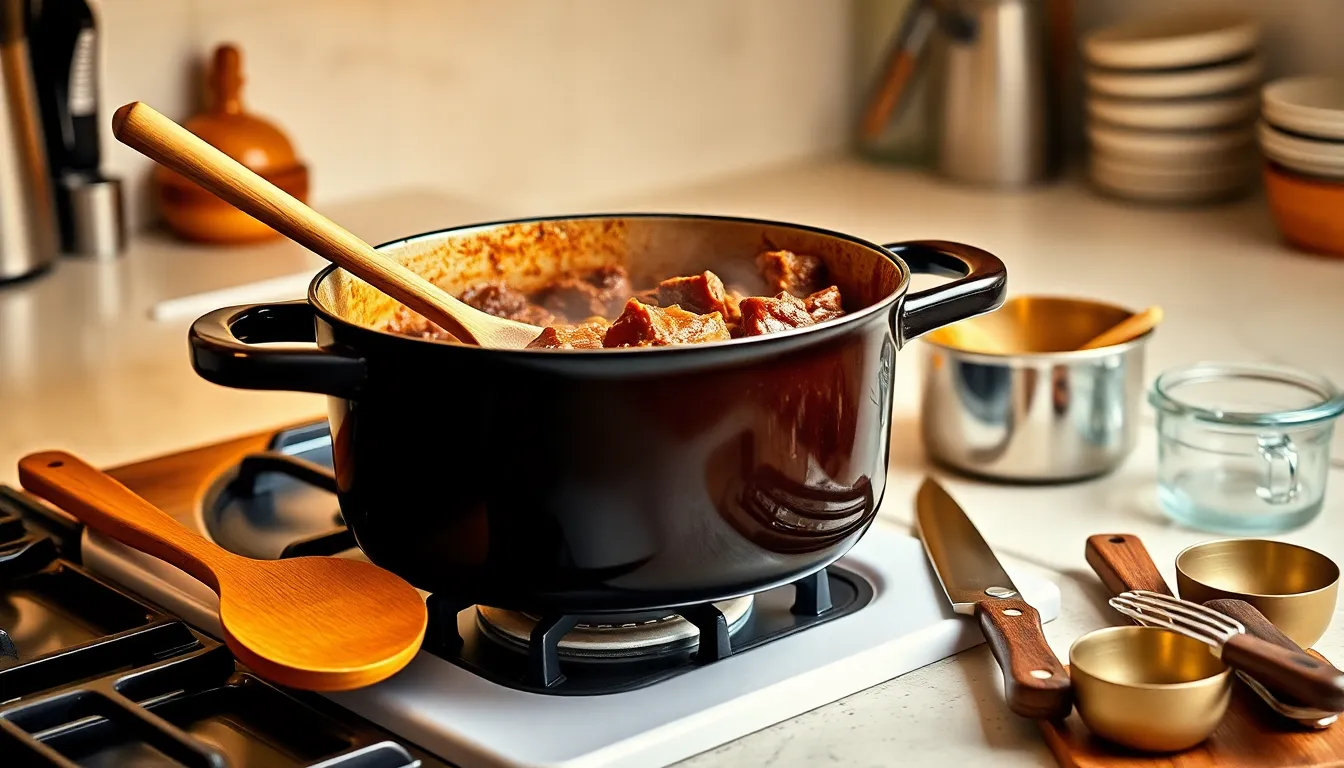
Creating the perfect stovetop beef stew requires the right tools to achieve tender meat and perfectly cooked vegetables. We’ve compiled this essential equipment list to ensure your cooking process runs smoothly from start to finish.
Large Heavy-Bottomed Pot or Dutch Oven
Our top priority is selecting a heavy-bottomed pot or Dutch oven that allows for even heat distribution throughout the long cooking process. This essential piece of equipment prevents hot spots that could burn your ingredients while ensuring consistent slow cooking results. We recommend a 5 to 6-quart capacity to accommodate all ingredients comfortably.
Wooden Spoon or Heat-Resistant Spatula
We rely on these tools for stirring ingredients and scraping up those precious browned bits from the bottom of the pot. The wooden spoon works particularly well for deglazing without scratching your cookware surface.
Sharp Knife and Cutting Board
Proper preparation starts with clean cuts of both meat and vegetables. We use a sharp chef’s knife to cut beef into uniform bite-sized pieces and chop all vegetables consistently for even cooking.
Measuring Tools
Accurate measurements ensure balanced flavors in every batch. We keep both measuring spoons and measuring cups handy for precise liquid and seasoning additions.
Ladle for Serving
Serving becomes effortless with a quality ladle that can handle the hearty chunks of beef and vegetables while capturing plenty of that rich broth.
| Equipment Item | Purpose | Size Recommendation |
|---|---|---|
| Dutch Oven/Heavy Pot | Even heat distribution | 5-6 quart capacity |
| Wooden Spoon | Stirring and deglazing | Standard size |
| Chef’s Knife | Cutting meat and vegetables | 8-10 inch blade |
| Measuring Cups | Liquid ingredients | Set with 1-4 cup sizes |
| Measuring Spoons | Seasonings and small amounts | Standard tablespoon/teaspoon set |
Having these tools ready before you begin cooking streamlines the entire process and helps achieve professional results in your home kitchen.
Instructions

We’ll walk through each step to create the perfect stovetop beef stew with tender meat and rich flavors. This methodical approach ensures consistent results every time.
Prep the Ingredients
Cut beef stew meat into uniform bite-size pieces if your butcher hasn’t already done this step. Peel and chop onions, carrots, celery, and potatoes into similar-sized pieces for even cooking. Mince garlic cloves and set aside separately from other vegetables.
Mix your dry seasonings in a small bowl: salt, pepper, garlic powder, onion powder, and Italian seasoning. Keep browning sauce or Worcestershire sauce nearby for easy access during cooking.
Brown the Beef
Heat oil in your large Dutch oven or heavy pot over medium-high heat until it shimmers. Add half the beef pieces without overcrowding the pot, then sprinkle seasoning mixture on top. Brown beef on all sides for 2 to 3 minutes per side to lock in juices and develop deep flavor.
Transfer browned beef to a plate and repeat the process with remaining meat. Add more oil as necessary between batches to prevent sticking.
Sauté the Aromatics
Add chopped onions, celery, and garlic to the same pot using the flavorful drippings. Sauté vegetables until they soften and become fragrant, approximately 5 minutes. Stir in tomato paste and cook briefly to combine ingredients and deepen the flavor profile.
Build the Stew Base
Pour in red wine if using, followed by beef broth, Worcestershire sauce, and bay leaves. Scrape up all the browned bits from the bottom of the pot using your wooden spoon for maximum richness. Return browned beef with any accumulated juices to the pot.
Bring the mixture to a rolling boil, then reduce heat to low and cover. Simmer for 1½ to 2 hours until beef becomes fork-tender and easily shreds.
Add Vegetables and Simmer
Add potatoes, carrots, and any other desired vegetables to the tender beef mixture. Raise heat to bring stew back to a boil, then reduce to low heat and cover again. Cook for another 30 to 45 minutes until vegetables are tender but still hold their shape.
Stir in frozen peas and fresh parsley during the final 5 minutes of cooking time.
Final Seasoning and Thickening
Mix water with cornstarch in a small bowl to create a smooth slurry without lumps. Stir the slurry into the simmering stew and cook uncovered until the liquid thickens to your desired consistency.
Taste and adjust salt, pepper, and other seasonings as needed. Remove bay leaf before serving to prevent any bitter flavors.
Cooking Tips for Perfect Stove Top Beef Stew

Choose the Right Cut of Meat
We recommend selecting beef chuck roast with marbling throughout the meat. The fat melts during the slow cooking process and transforms tough fibers into incredibly tender pieces while keeping the stew moist and flavorful. Chuck roast contains the perfect balance of meat and fat that breaks down beautifully during our extended simmering time.
Master the Searing Technique
Browning the beef properly creates the foundation for deep flavor in our stew. We heat oil until it shimmers in the pot before adding meat pieces in a single layer. Each piece needs space to develop a golden brown crust that locks in juices and adds rich color to our final dish. Avoid overcrowding the pot as this creates steam instead of the caramelization we want.
Embrace Low and Slow Cooking
Our stew requires patience for the best results. We maintain medium-low or low heat for 1.5 to 2 hours to allow tough meat fibers to break down naturally. Higher temperatures toughen the meat and prevent proper tenderization. The gentle bubbling action we maintain during simmering ensures our beef becomes fork tender without falling apart.
Time Your Vegetables Strategically
We add vegetables in stages to maintain their ideal texture. Hard vegetables like potatoes and carrots go into the pot during the final 30 to 45 minutes of cooking time. This prevents them from becoming mushy while ensuring they absorb the rich flavors of our stew base.
Build Complex Flavors
Red wine and Worcestershire sauce elevate our stew from good to exceptional. We use Cabernet, Zinfandel, or Merlot to add depth and richness to the broth. The alcohol cooks off during simmering while leaving behind concentrated flavors that complement the beef perfectly.
Perfect Your Thickening Method
We create a cornstarch slurry by mixing equal parts cornstarch and cold water when our stew needs thickening. This mixture gets stirred into the hot stew during the final minutes of cooking to achieve the perfect consistency without lumps. The stew should coat the back of a spoon when properly thickened.
Monitor and Maintain Your Stew
Skimming excess fat or foam from the surface keeps our broth clear and clean tasting. We check our stew periodically and remove any impurities that rise to the top. This simple step makes a noticeable difference in the final appearance and flavor of our finished dish.
Make-Ahead Instructions

We love making this beef stew ahead of time because the flavors actually improve and deepen overnight. The slow melding of ingredients creates an even richer and more complex taste profile that transforms this already delicious dish into something extraordinary.
Our beef stew can be prepared completely up to 2 days in advance. After cooking the stew according to our recipe instructions we allow it to cool completely at room temperature before transferring it to the refrigerator. This cooling process prevents condensation from forming inside the storage container which could dilute the concentrated flavors we worked so hard to develop.
When we’re ready to serve our make ahead beef stew we reheat it gently on the stovetop over low heat. We stir the stew occasionally during reheating to ensure even warming and prevent any sticking to the bottom of the pot. The gentle reheating process preserves the tender texture of both the beef and vegetables.
We often notice that refrigerated stew becomes thicker after sitting overnight. The starches from the potatoes and any flour used for coating the beef continue to work their magic even while chilled. If our stew appears too thick during reheating we simply add a small amount of beef broth or water to achieve our desired consistency.
Storage becomes effortless when we divide larger batches into individual serving containers. This approach allows us to reheat only what we need while keeping the remaining portions fresh in the refrigerator. We can also freeze portions for up to 3 months though we recommend consuming refrigerated portions within 2 days for optimal flavor and food safety.
The make ahead method works particularly well for entertaining since we can focus on our guests rather than spending time in the kitchen. We prepare the stew the day before our dinner party and simply reheat it when needed. This strategy ensures we serve a perfectly developed dish while maintaining a stress free hosting experience.
Storage and Reheating
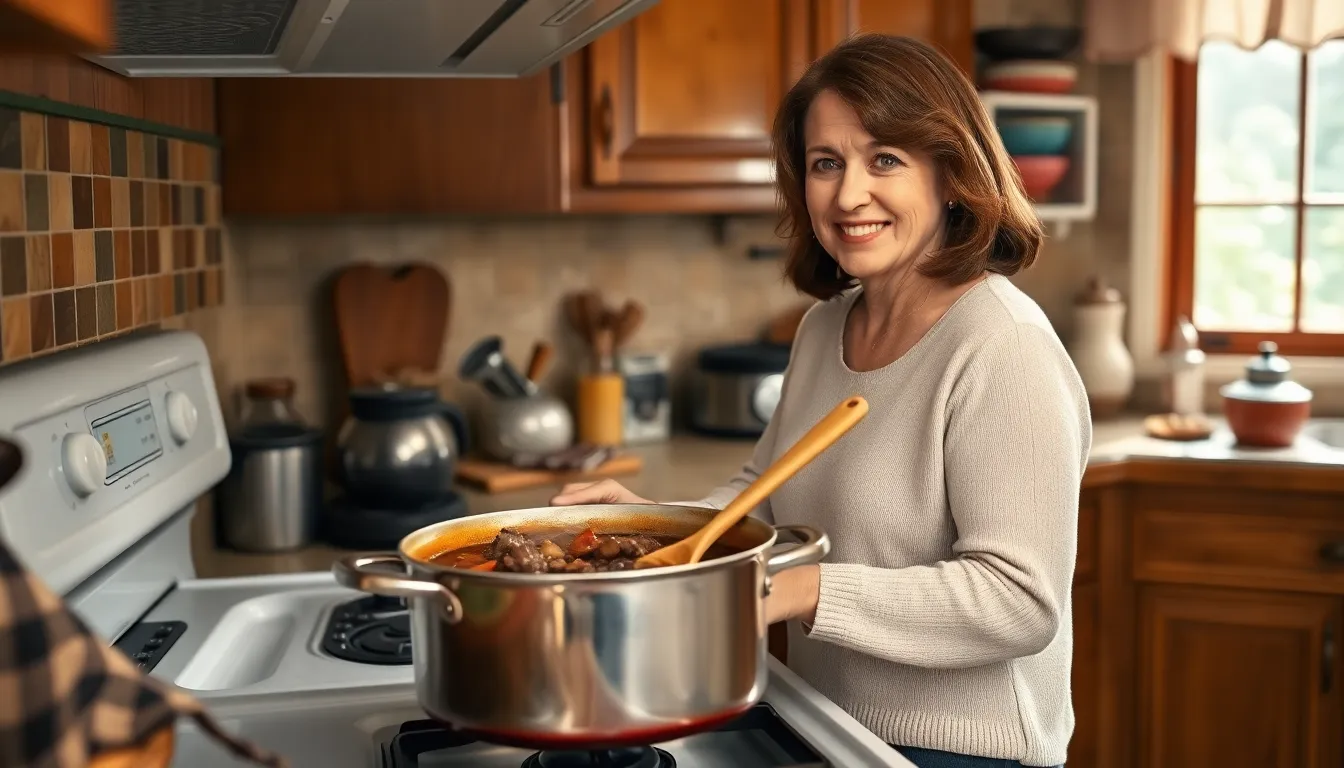
Proper storage techniques ensure our homemade beef stew maintains its rich flavors and hearty texture for future meals. We can store leftover stew in an airtight container in the refrigerator for up to 3 days while preserving both taste and quality. The flavors actually improve during this time as the ingredients continue to meld together.
For longer storage periods, we recommend freezing the stew for up to 3 months in freezer-safe containers or heavy-duty freezer bags. We should leave about an inch of headspace in containers to allow for expansion during freezing. When we’re ready to enjoy our frozen stew, we need to thaw it completely in the refrigerator overnight before reheating.
Refrigerator Storage Method
| Storage Duration | Container Type | Temperature |
|---|---|---|
| Up to 3 days | Airtight container | 40°F or below |
| Up to 3 months (frozen) | Freezer-safe container | 0°F or below |
Reheating Techniques
We can reheat our beef stew using two effective methods depending on our time constraints. The stovetop method gives us the best results by warming the stew over medium heat while stirring frequently to prevent sticking. This gentle reheating process helps maintain the tender texture of our beef and vegetables.
For quicker reheating, we can use the microwave by heating the stew in 30-second intervals and stirring between each interval. This approach ensures even heating throughout the stew and prevents hot spots that could overcook the ingredients. We should always verify the stew reaches an internal temperature of 165°F before serving.
The low and slow reheating approach works best for maintaining the stew’s original texture and preventing the beef from becoming tough. We avoid high heat during reheating just as we did during the initial cooking process to ensure our carefully developed flavors remain intact.
Serving Suggestions
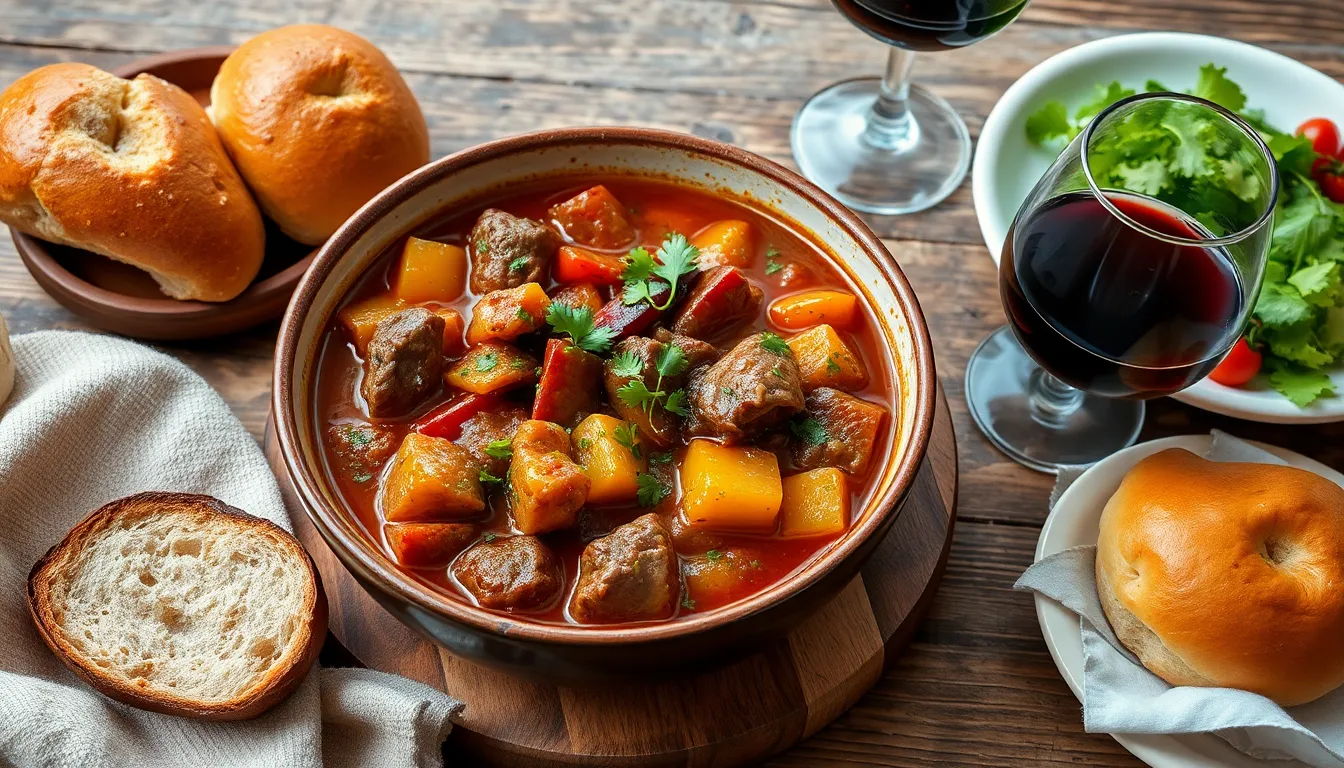
Our stovetop beef stew transforms into a complete meal with the right accompaniments. We recommend ladling the hearty stew into deep bowls while it’s still steaming hot to showcase its rich aromas and inviting appearance.
Crusty bread makes an exceptional pairing that allows diners to soak up every drop of the savory broth. The bread’s crispy exterior and soft interior provide the perfect textural contrast to the tender beef and vegetables. Alternatively, we love serving this stew over a bed of egg noodles or creamy mashed potatoes for a more substantial presentation.
Fresh steamed green beans add vibrant color and a crisp texture that balances the stew’s richness beautifully. A simple garden salad with mixed greens brings lightness to the meal and helps cleanse the palate between hearty spoonfuls.
Wine enthusiasts will appreciate pairing this dish with a robust red wine similar to the medium to full-bodied wine used in the cooking process. Cabernet Sauvignon or Merlot complement the deep flavors while echoing the wine notes already present in the stew.
We find that garnishing each bowl with fresh chopped parsley not only adds a pop of bright green color but also provides a fresh herb note that enhances the overall flavor profile. This simple finishing touch elevates the presentation from rustic to restaurant quality.
For family-style serving, we recommend placing the pot directly on the table with a quality ladle alongside warm dinner rolls or biscuits. This approach creates an inviting atmosphere that encourages sharing and conversation around this comforting dish.
Recipe Variations
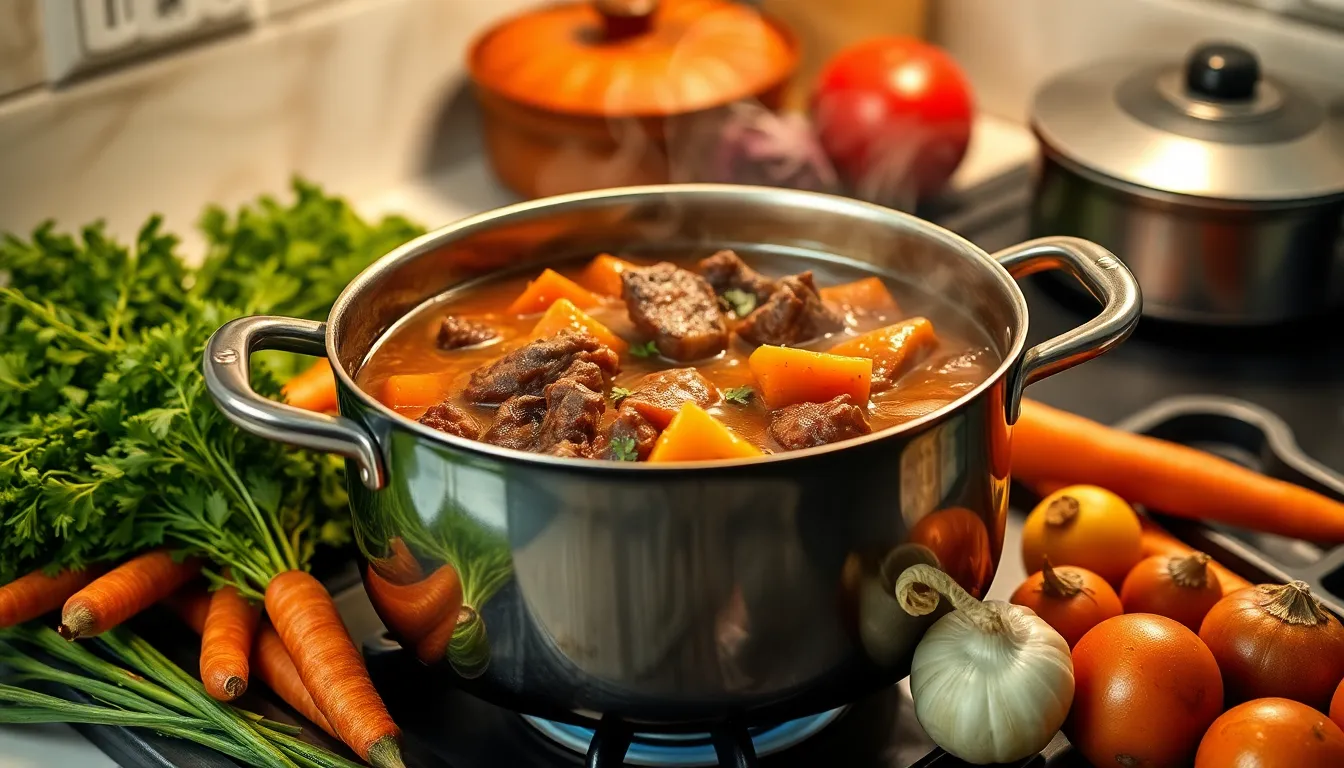
Our stovetop beef stew serves as the perfect foundation for exploring different flavor profiles and regional influences. Each variation builds upon our core cooking techniques while introducing unique ingredients and methods that transform this comfort food classic.
Classic Beef Stew
We prepare our classic beef stew by seasoning beef chuck cubes with salt and pepper before searing them in vegetable oil until deeply browned. This foundational step locks in the beef’s natural juices and creates the rich flavor base that defines traditional beef stew. After searing the meat we add beef broth, minced garlic, fresh herbs, and sometimes a splash of red wine to the pot before bringing the mixture to a rolling boil.
Our method involves simmering the stew covered on medium-low heat for approximately 90 minutes until the beef becomes fork-tender. During this slow cooking process the tough muscle fibers break down completely while the flavors meld together beautifully. We then add our vegetables including carrots, onions, potatoes, and celery along with canned whole tomatoes and a pinch of sugar to balance the acidity. The vegetables cook until they reach the perfect tender texture while maintaining their individual character in every spoonful.
Irish-Style Beef Stew
Our Irish-style variation emphasizes the natural flavors of root vegetables and aromatic fresh herbs that define traditional Irish cooking. We focus heavily on carrots, potatoes, and onions as the primary vegetables while incorporating generous amounts of fresh thyme and rosemary throughout the cooking process. This approach creates layers of earthy flavors that complement the rich beef perfectly.
The key to our Irish-style stew lies in the slow gentle simmering technique that allows the beef fibers to break down naturally for maximum tenderness. We sometimes substitute beef stock with dark stout beer to deepen the overall flavor profile and add authentic Irish character to the dish. Our method requires patience as we simmer the stew slowly on the stovetop while carefully layering seasonings and fresh ingredients to build complex flavors that develop over time.
Wine-Braised Beef Stew
We elevate our beef stew by incorporating red wine braising techniques that enhance both richness and aromatic complexity. After searing the beef cubes we combine beef broth with a generous amount of red wine in our Dutch oven along with garlic and fresh herbs. This wine-forward approach creates a sophisticated flavor foundation that sets this variation apart from traditional recipes.
Our wine-braised method involves bringing the liquid mixture to a vigorous boil before covering and simmering on low heat for up to 2 hours. The extended cooking time allows the wine to integrate fully while the beef becomes incredibly tender and infused with deep burgundy flavors. We add canned tomatoes and our vegetable medley during the final cooking stage to preserve their texture while allowing them to absorb the rich wine-infused broth. The result produces exceptionally tender beef with a slightly tangy sauce that showcases bold wine characteristics throughout every bite.
Conclusion
We’ve shared everything you need to create an exceptional stovetop beef stew that’ll become a family favorite. With the right ingredients quality cuts proper technique and patience you’ll achieve restaurant-quality results in your own kitchen.
The beauty of this recipe lies in its flexibility and forgiving nature. Whether you’re following our classic version or exploring the Irish or wine-braised variations you’re guaranteed a hearty satisfying meal that improves with time.
Remember that great beef stew isn’t just about following steps—it’s about understanding how flavors develop and textures transform through slow cooking. We’re confident this recipe will deliver the comfort food experience you’re seeking every single time.
Frequently Asked Questions
What cut of beef is best for beef stew?
Beef chuck roast is the ideal cut for beef stew due to its excellent marbling and rich flavor. This tough cut becomes incredibly tender when cooked using the low and slow method, breaking down the connective tissues to create melt-in-your-mouth pieces that absorb the stew’s flavors perfectly.
How long should I cook beef stew on the stovetop?
Beef stew should simmer on low heat for approximately 1.5 to 2 hours until the meat becomes fork-tender. The exact cooking time depends on the size of your beef pieces and heat level. Always cook on low heat to prevent the meat from becoming tough.
Can I make beef stew ahead of time?
Yes, beef stew actually improves when made ahead of time. The flavors deepen and develop overnight in the refrigerator. Cool the stew completely before storing, then reheat gently on the stovetop over low heat, stirring occasionally to maintain the texture of the beef and vegetables.
What equipment do I need to make beef stew?
You’ll need a large heavy-bottomed pot or Dutch oven for even heat distribution, a sharp knife and cutting board for prep work, measuring cups and spoons for accurate seasoning, a wooden spoon for stirring, and a quality ladle for serving the finished stew.
How do I thicken my beef stew?
Create a cornstarch slurry by mixing equal parts cornstarch and cold water, then stir it into the simmering stew. Cook for a few minutes until the stew reaches your desired thickness. Alternatively, you can mash some of the potatoes against the pot sides to naturally thicken the broth.
How long can I store leftover beef stew?
Leftover beef stew can be stored in the refrigerator for up to 3 days in an airtight container. For longer storage, freeze the stew for up to 3 months in freezer-safe containers, leaving some headspace for expansion. The flavors actually improve as ingredients meld together.
What vegetables work best in beef stew?
Traditional beef stew vegetables include carrots, potatoes, onions, and celery. Add root vegetables like carrots and potatoes during the last 30-45 minutes of cooking to maintain their texture. Onions and celery can be added earlier as they help build the flavor base.
Should I brown the beef before adding it to the stew?
Yes, browning the beef is crucial for developing deep, rich flavors. Sear the beef pieces in batches to avoid overcrowding, which creates steam instead of browning. This step locks in juices and creates a flavorful foundation that enhances the entire stew.
What wine pairs well with beef stew?
Robust red wines like Cabernet Sauvignon or Merlot complement beef stew perfectly. These full-bodied wines match the rich, hearty flavors of the dish. You can also use red wine in the cooking process to add depth and complexity to the stew’s flavor profile.
How do I reheat beef stew properly?
Reheat beef stew slowly on the stovetop over low heat, stirring occasionally to prevent sticking. For microwave reheating, use 50% power and stir frequently. Ensure the stew reaches an internal temperature of 165°F. Add a splash of broth if needed to restore consistency.

























